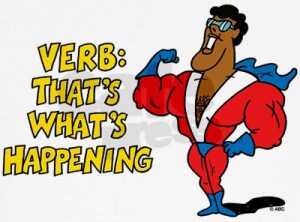Verb tenses can get complicated depending on the language. So in the interest of not going down that road, we’re not even going to invite things like past perfect, subjunctive, pluperfect and such to the party.
Generally speaking, fiction writers choose either past or present tense for their narratives. We could try writing in future tense – and I think I recall a couple of experimental short stories someone wrote that way – but this stretches reader expectations to the breaking point and puts more emphasis on the verb tense than a writer usually wants. In other words, it’s distracting and not sustainable for a long work.
Which leaves us with our friends past and present. Depending on the genre in which a writer originally cut their narrative teeth, we may be more comfortable in one than the other. SFF writers tend to be more comfortable with the past tense while erotic and sometimes romance writers lean toward the present.
Some of this has to do with POV, too. First-person POV’s lend themselves more easily to present tense. It’s a more intimate narrative setting. The main characters take us along for the ride in their heads so present tense can feel more natural. I know lots of folks out there are cringing and saying “I hate present tense.” But when it’s done well, there are valid reasons for using it – to limit our vision as readers, to bring the reader along as a confidante, sometimes even to put the reader inside the head of an unreliable narrator which may serve to create clever narrative blind spots.
No matter which route the writer chooses, it’s important to then pay attention to consistency in tense choices. Switching back and forth between past and present is a common mistake of the inexperienced writer – and writers seeking publication should be beyond that point. Present should stay present. Past should stay past. There are, of course…wait for it…exceptions.
Flashbacks: Stop wincing, writing instructors. Sometimes a writer needs them. Sometimes they’re part of the narrative structure. When writing a present tense story, flashbacks can certainly flip to past tense. I would suggest using this device sparingly, as a general rule.
Internal monologue: When writing past tense, sometimes a writer lets us see directly inside the character’s head where said character is having thinky thoughts and possibly a conversation with him/her/themselves. Since the character is present in that moment, these usually flip over to present tense. (More often than not in italics as well to give the reader a clue and not cause a jarring, throw-reader-out-of-the-story moment.)
Breaking the Fourth Wall: Everyone ‘s seen this illustrated in bright, shiny, unicorn rainbow colors with Deadpool recently. But authors use this device all the time where the character suddenly turns to the reader and says, “You know how such and such often happens?” and so on. Keep in mind that the character is speaking directly to the audience and a present tense conversational tone works best. I recently read a book (one I was very much enjoying) where the sarcastic main character breaks the wall – and it was in past tense. It read so oddly, the moment was so jarring, that I read the passage several times to be sure and forgot where I was in the story. Don’t do this to your readers.
So watch those tense situations carefully and if it sounds off? It probably is.



